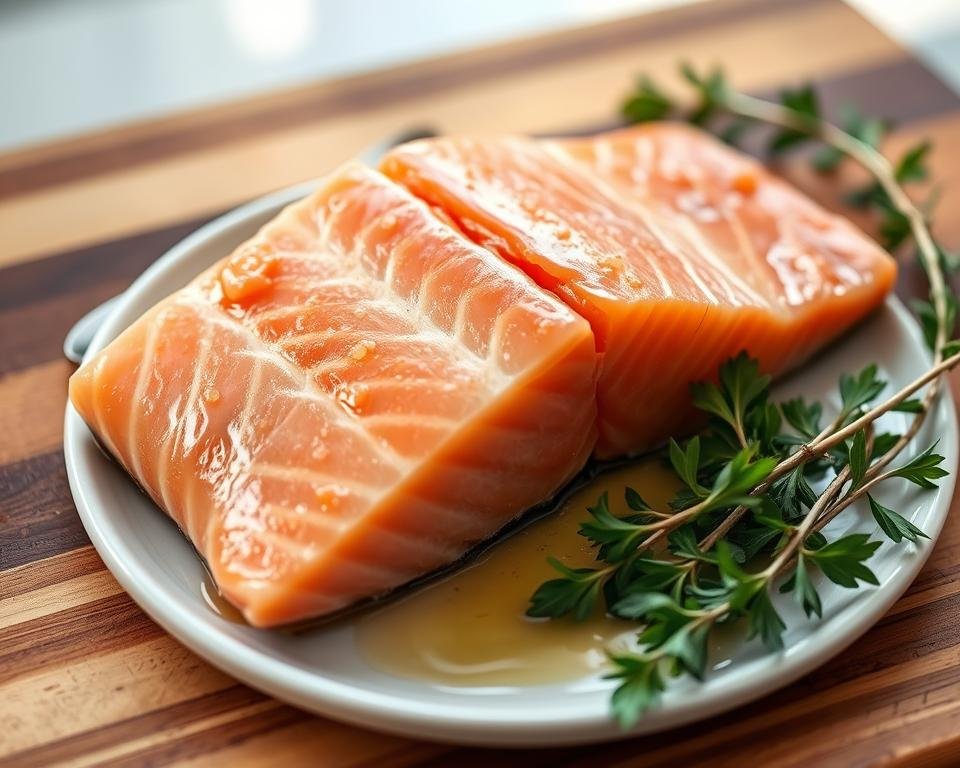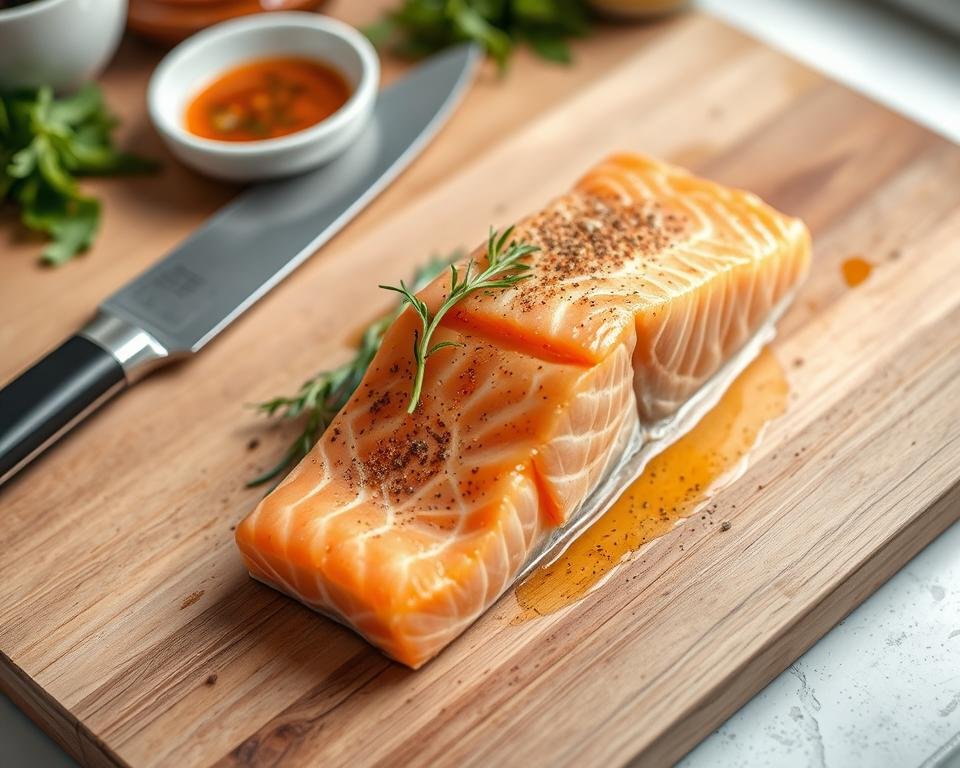Eating undercooked salmon can make you sick. You might get salmonellosis, norovirus, or Vibrio infections. These can cause diarrhea, fever, vomiting, and even blood infections.
To stay safe, cook salmon to 145°F (63°C). This kills harmful bacteria and parasites.
Understanding the Risks of Consuming Undercooked Salmon
Eating raw or undercooked salmon can be very dangerous. It may contain harmful bacteria and parasites. Salmonella, norovirus, and Vibrio infections are some of the foodborne illness symptoms from eating undercooked salmon.
These pathogens grow best in temperatures between 40°F and 140°F. This makes undercooked salmon a perfect place for them. Symptoms like diarrhea, fever, nausea, and vomiting can happen. In severe cases, infections can even cause blood infections.
Potential Foodborne Illnesses from Undercooked Salmon
Salmonella bacteria in raw or undercooked salmon can cause diarrhea, fever, and stomach cramps. Norovirus, found in contaminated seafood, can lead to nausea, vomiting, and diarrhea. Vibrio bacteria in undercooked salmon can cause infections like Vibrio parahaemolyticus and Vibrio vulnificus. These infections can cause fever, vomiting, and diarrhea.
Bacteria and Parasites That Thrive in Undercooked Temperatures
Dehydration from foodborne illnesses in undercooked salmon is very dangerous. It’s a big risk for young children and the elderly. Cooking salmon to the right temperature of 145°F (63°C) is key to avoid these risks and keep salmon safe to eat.

What is Considered Undercooked Salmon?
Salmon is undercooked if it’s not hot enough inside. It looks raw and feels soft. You can’t easily flake it with a fork.
The USDA says salmon should be 145°F (63°C) inside to be safe. Cooking it to 120° to 125°F (49° to 52°C) makes it taste better. But, it might not be safe.
Eating raw or undercooked salmon can make you sick. You might get parasites or bacterial infections. Symptoms include nausea, vomiting, and diarrhea.
“To ensure salmon is safe to eat, it can be held at 131°F for 5 hours. This temperature and time combination effectively kills any what does undercooked salmon look like and can you eat undercooked salmon
Recommendations for Cooking Salmon to a Safe Temperature
When cooking salmon, it’s key to reach an internal temperature of at least 145°F (63°C). This ensures that harmful bacteria or parasites are killed. Using a food thermometer is best, as visual signs like color can be misleading.
The Recommended Internal Temperature for Cooked Salmon
The USDA says cooked salmon should be at least 145°F (63°C). This temperature kills Listeria, a harmful bacteria. Cooking it to 125°F (52°C) is riskier and not safe for everyone.
Tips for Achieving the Perfect Salmon Doneness
To get the perfect salmon, follow these tips. For a medium-rare, cook to 120-125°F (49-52°C). This gives a pink center. For medium, aim for 125-140°F (52-60°C), with flesh that’s fully opaque and firm.
For well-done, cook to 140-150°F (60-66°C). The flesh should be firm and no pink. Always use a food thermometer to check the temperature accurately.

The Debate: Medium or Well-Done Salmon?
There’s a big debate about cooking salmon. Some like it medium, while others prefer it well-done. It all comes down to taste and how much risk you’re okay with.
Medium-rare salmon is loved for its soft, flaky texture and mild taste. But, it’s riskier than cooking it to 145°F (63°C). Well-done salmon is safer because it kills off any bad bacteria. But, it can be drier and tougher.
“Only about 10% of imported raw seafood and 3% of domestic seafood tested positive for Salmonella in one U.S. study.”
Choosing between salmon medium or salmon well-done depends on what you value more. If you want to be safe, go for well-done. But, if you love the softness of medium-rare, the risk might be worth it.

No matter what you prefer, it’s key to follow safe food handling and cooking. This way, you can enjoy salmon’s taste and health benefits, whether it’s medium or well-done.
Who Should Avoid Undercooked Salmon?
Many people love the taste of salmon. But, some groups should not eat undercooked salmon. This is because it can cause serious foodborne illnesses.
Pregnant women and those with weak immune systems are at high risk. They can get very sick from eating undercooked salmon. This is because harmful bacteria and parasites can grow in the fish.
“Consuming raw or undercooked meats, poultry, seafood, shellfish, or eggs increases the risk of foodborne illness.”
To stay safe, these groups should cook salmon to 145°F (63°C). This temperature kills harmful bacteria and parasites. It makes eating salmon safer.
By following this advice, these groups can enjoy salmon’s health benefits. They can do so while keeping themselves safe and healthy.
Signs and Symptoms of Eating Undercooked Salmon
Eating salmon that’s not cooked right can make you very sick. You might feel nauseous, vomit, have stomach pain, diarrhea, and a fever. These problems come from harmful bacteria like Salmonella or viruses like norovirus in the salmon.
Common Foodborne Illness Symptoms from Undercooked Salmon
Salmonella can make you sick 6 hours to 6 days after eating bad salmon. You might have really bad stomach pain, diarrhea for up to 10 days, and a high fever. People who are young, old, or have weak immune systems can get even sicker.
Vibrio vulnificus bacteria can also be a big risk. It can cause serious infections, but it’s not very common. Symptoms like vomiting, diarrhea, and fever can show up in 24-72 hours. If you get any of these symptoms of eating undercooked salmon or food poisoning from salmon, see a doctor right away.
“Consumption of raw or undercooked seafood, including salmon, increases the risk of foodborne illness.” – Centers for Disease Control and Prevention (CDC)
To stay safe, make sure your salmon is cooked to 145°F (63°C) or higher. This way, you can enjoy salmon’s health benefits without getting sick.
How to Tell if Your Salmon is Undercooked
Preparing salmon right is key for taste and safety. Undercooked salmon can be risky, as it might have harmful bacteria. Luckily, there are easy ways to check if your salmon is cooked enough.
Using a Food Thermometer to Check Salmon Doneness
The best way to know if salmon is cooked is with a food thermometer. It should read at least 145°F (63°C) at its thickest part. An instant-read thermometer in the center will show if it’s done.
Other Visual and Textural Cues for Undercooking
There are other signs of undercooked salmon too. It will look dark pink and translucent in the middle. You might see albumin, a white substance, on the surface. Also, undercooked salmon won’t flake easily with a fork.
“Consuming raw or undercooked meats, poultry, seafood, shellfish, or eggs increases the risk of foodborne illness.”
Pay attention to the temperature and these signs to make sure your salmon is safe and tasty. This way, you avoid the dangers of undercooked salmon.
Undercooked Salmon and Food Safety Practices
Keeping food safety for salmon in check is key to avoid harmful bacteria. This is important to prevent foodborne illnesses. When handling salmon, it’s vital to follow the right steps. This ensures the quality and safety of this popular seafood.
Proper Handling and Storage of Salmon
To keep salmon safe, it must be stored at 40°F (4°C) or below. Raw salmon needs to be cooked to 145°F (63°C) to kill harmful bacteria. This includes Salmonella, Vibrio, and Listeria. It’s also important to thaw frozen salmon in the fridge and not leave it at room temperature for too long.
Proper handling and storage of salmon can help reduce the risk of foodborne illnesses caused by undercooked or mishandled seafood.
Salmon is the third most popular seafood in the US. It’s essential to follow food safety for salmon guidelines. By sticking to recommended salmon handling practices, you can enjoy its delicious and nutritious benefits safely.
The Risk of Eating Raw or Undercooked Salmon
Some people love the taste of raw or undercooked salmon, like in sashimi or tartare. But, it’s important to know the risks. Eating salmon that’s not cooked right can lead to harmful bacteria and parasites. This can cause serious foodborne illnesses.
The safe internal temperature for cooked salmon is at least 145°F (63°C). This kills off any harmful bacteria. Symptoms of food poisoning from eating raw salmon risks can start as soon as six hours after eating. They include nausea, vomiting, diarrhea, and more.
“Cooking salmon to the proper internal temperature is essential for food safety and reducing the risks of undercooked salmon,” states the FDA.
Pregnant women and those with weak immune systems should avoid undercooked salmon. They are more likely to get very sick from foodborne illnesses. Cooking salmon well and using a food thermometer helps avoid these illnesses.
It’s also key to handle and store salmon safely. Following these steps can protect your health. This way, you can enjoy salmon’s taste and health benefits without worrying about getting sick.
Identifying Safe Options for Consuming Raw Salmon
Raw salmon can be risky if not handled right. But, there are safe ways to enjoy it. The trick is to pick high-quality, frozen salmon that’s been treated to kill harmful germs.
Choosing High-Quality, Properly Frozen Salmon
Look for labels that say “sushi-grade” or “sashimi-grade” when buying raw salmon. This means it’s been frozen to kill parasites. The salmon should be firm, smell fresh, and have a bright, translucent flesh.
It’s key to handle and store raw salmon safely. Seafood should be kept in a clean fridge at 40°F (4°C) or below for 2 days. Always wash cutting boards and utensils with soap and hot water after handling raw foods.
“Some species of fish can contain parasites, which freezing can help eliminate.”
By choosing the right salmon and following safety tips, you can enjoy raw salmon safely. But, some people should avoid it. This includes pregnant women, young kids, older adults, and those with weak immune systems to avoid foodborne illness.
Conclusion
While undercooked salmon might seem appealing, it’s important to know the health risks. Eating salmon that’s not cooked to 145°F (63°C) can lead to serious illnesses. Cooking salmon to the right temperature and following food safety tips can help you enjoy it safely.
Undercooked salmon can have harmful bacteria like Salmonella and Norovirus. These can cause symptoms like diarrhea and fever. It’s vital to cook salmon well to avoid these problems.
By focusing on food safety and cooking salmon right, you can enjoy its taste without risks. Remember, well-cooked salmon is not only tasty but also packed with nutrients. It’s a healthy and safe choice for your meals.





Pingback: Can Cats Eat Seaweed: A Guide to Feeding Your Feline